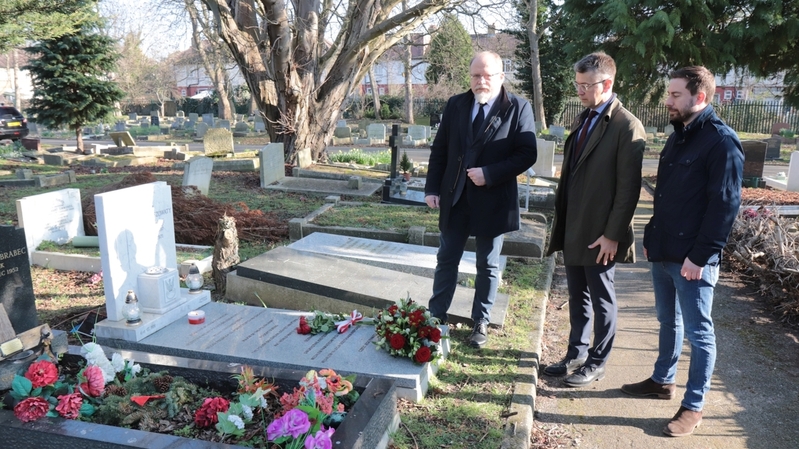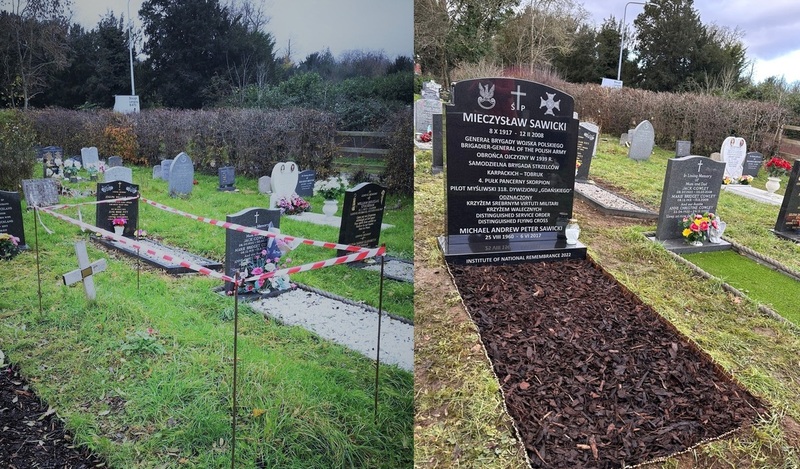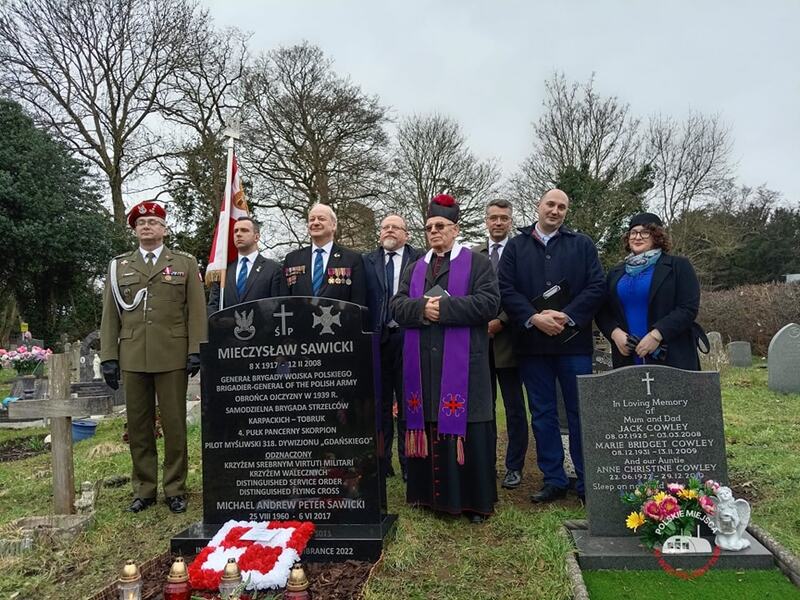The ceremony of consecration the tombstone of General Mieczyslaw Sawicki took place at the St. Peter Churchyard cemetery in Iver, near London on the 15th anniversary of the General's death. The gravestone monument was funded by the IPN's Office for Commemorating the Struggle and Martyrdom. The event was attended by the Consul of the Republic of Poland Tomasz Balcerowski and the Director of the Office for Commemorating the Struggle and Martyrdom Adam Siwek. The ceremony was also witnessed by representatives of the Polish community in the UK, including the President of the Association of Polish Airmen in the UK Artur Bildziuk and a representative of the Polish Places in the UK website Marcin Kunicki. General Sawicki's daughter Sophie Sawicka, who lives permanently in Spain, came especially for the event. The gravestone was consecrated by the Deputy Director of the Polish Catholic Mission in England and Wales, Rev. Prof. Władysław Wyszowadzki.
Biography of General Mieczylsaw Sawicki
Mieczysław Sawicki was born on 8 October 1917 in Niemiercze near Kyiv. He attended King Bolesław the Brave High School in Grudziądz. He was a cadet at the Armoured Weapons Officer Cadet School in Modlin. After graduating, he was assigned to the 2nd Armoured Battalion in Żurawica. He was taken prisoner by the Soviets during the 1939 defensive campaign, but he managed to escape. Then, he participated in underground activities as an intelligence officer of the Polish Victory Service/Union of Armed Struggle. He left Poland to avoid being arrested by the Germans and made his way to Palestine, where he became the intelligence officer of the 2nd Rifle Battalion of the Independent Carpathian Rifle Brigade. He took part in the battles in Tobruk and became famous for his daring intelligence actions and heroism in rescuing his wounded subordinates, for which he was awarded the Order of Virtuti Militari. After the end of the fighting in Africa, he became an officer in the 4th Armoured Regiment ‘Scorpion’ and then, at his request, was assigned to fighter aviation. In 1944, he was assigned to the No. 318 Fighter-Reconnaissance Squadron of Gdańsk and flew 103 combat missions on the Italian front. Great Britain presented Sawicki with two of its highest military awards, the Distinguished Service Order and the Distinguished Flying Cross, in recognition of his wartime achievements.
After the war, he graduated in engineering from the University of London and then worked for British construction companies. He was secretary of the Chapter of the War Order of Virtuti Militari in London. In independent Poland, he was a member of its Chapter from 1993 until his death. He was promoted to the rank of Brigadier General of the Polish Armed Forces by the President of the Republic of Poland, Lech Kaczyński. He died on 12 February 2008 in Iver Bucks near London. In 2022, the legacy of General Mieczysław Sawicki was transferred to the IPN Archives as part of the Archiwum Pełne Pamięci project.
On 13 February, ceremonies were held at the grave of Maj. Ryszard Wiszowaty in London's South Ealing Cemetery. Flowers and candles were laid by the Consul of the Republic of Poland Tomasz Balcerowski and the Director of the Office for Commemorating the Struggle and Martyrdom, Adam Siwek.
Biography of Major Richard Wiszowaty
Ryszard Wiszowaty was born on 10 September 1894 in Wiszowate. From an early age, he was involved in underground activity; during his education at St Catherine High School in St Petersburg, he belonged to the Student Fraternity Fund and the Student Self-Education Circle. In November 1918, he disarmed the Germans in Knyszyn and the surrounding area. As a volunteer, he participated in the Polish-Bolshevik War, serving in the Tatar Cavalry Regiment from February to September 1919. He was awarded the Cross of Valour for a skirmish near the village of Wiekszyce near Minsk in Belarus. After the combat operations ended, he remained in the Polish Army, serving in the 10th Lithuanian Uhlan Regiment and then in the Command of the Fortified Area ‘Vilnius’. His qualifications improved during courses and training, resulting in his promotion to the rank of cavalry captain in 1937. During the defensive war, he commanded the reserve squadrons in the ‘Vawkavysk’ covering regiment, which was part of the improvised Vawkavysk Cavalry Reserve Brigade. On 19 September, he took part in the Battle of Dubno; on 21 September, he fought at Kodziowce and then in defence of Grodno. He was interned in Lithuania; however, he escaped to France and joined the Polish Army. After France surrendered, he made his way to Great Britain and served in the Polish Armed Forces. After World War II, General Zygmunt Podhorski awarded him the Cross of Valour for fighting the Red Army in the south-eastern borderlands, followed by his promotion to the rank of major. He was actively involved in the life of the émigré community. He died on 2 September 1971 in London.
Veterans' graves
The graves of General Mieczysław Sawicki and Major Ryszard Wiszowaty are included in the register of graves of veterans of the struggle for freedom and independence of Poland. The record kept by the Institute of National Remembrance (IPN) includes veterans' graves located both on the territory of the Republic of Poland and outside its borders (Act on graves of veterans of the struggle for freedom and independence of Poland of 22 November 2018, Journal of Laws 2018, item 2529).
Veterans' graves are to include graves of persons who fought to regain Poland's independence or in defence of the autonomy and borders of the sovereign Republic of Poland, who took part in wars, military and independence activities and national uprisings from 1768 to 1963, as well as graves of officers of civilian commands of national uprisings, administration of the underground Polish State in the 1939–1945 war, members of the authorities and the Polish Government in exile in 1939–1990, and underground independence civilian organisations in 1945–1956.



